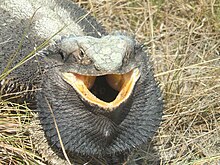Bearded dragons
| Bearded dragons | ||||||||||||
|---|---|---|---|---|---|---|---|---|---|---|---|---|

Striped-headed bearded dragon ( Pogona vitticeps ) |
||||||||||||
| Systematics | ||||||||||||
|
||||||||||||
| Scientific name | ||||||||||||
| Pogona | ||||||||||||
| Storr , 1982 |
The bearded dragons ( Pogona ) are a genus of scale reptiles from the agam family . The genus is distributed in Australia with currently eight recognized species .
description
Bearded dragons are medium to large sized lizards. They reach total lengths of 30 to 50 cm, with the tail accounting for half to two thirds of the total length. The body is weakly or severely flattened dorsoventrally , the legs are relatively short. The eardrum is exposed. The most striking feature are the many spines on the trunk, legs and tail, in particular a row of spines along the flanks, a row of spines on the base of the head and another row of spines on the rear edge of the lower jaw, which in most species extends over the throat and thus " Bart "forms. The animals are predominantly gray-brown in color, with dark gray or black patterns.
Through targeted breeding, color variations from white to yellow to red are also possible.
Distribution and types
Bearded dragons are found exclusively in Australia. Eight species are currently recognized. Most species inhabit tree- and bush-lined habitats, only
- Little Bearded Dragon ( Pogona henrylawsoni ) (Northeast Central Australia)
only inhabit semi-deserts with grass cover.
- Eastern bearded dragon ( Pogona barbata ) (Eastern Australia, often also lives in populated areas)
- Western bearded dragon ( Pogona minor ) (Western to Central Australia)
- Striped-headed bearded dragon ( Pogona vitticeps ) (Central to South Australia)
each colonize large parts of Australia;
- Kimberley Bearded Dragon ( Pogona microlepidota ) (Northwestern Australia)
- Little Bearded Dragon ( Pogona minima ) ( Houtman Abrolhos Archipelago , Western Australia)
- Mitchell's Bearded Dragon ( Pogona mitchelli ) (Western and Northern Australia)
- Nullarbor Bearded Dragon ( Pogona nullarbor ) ( Nullarbor Plain in southern central Australia)
have relatively small distribution areas.
Way of life

Almost all species are semi- arboricolous and like to rest on tree trunks, tree stumps or fence posts. Bearded dragons are omnivores and their diet includes small vertebrates , invertebrates , leaves, flowers and fruits. When threatened, the animals flatten their bodies and expand the throat with the beard by contracting muscles that attach to the cartilaginous structures of the throat (the so-called hyoid skeleton ). At the same time they open their mouths and present the yellow or pink inside of the mouth.
swell
literature
- Steve Wilson, Gerry Swan: A complete guide to reptiles of Australia. 3rd edition. New Holland Publishers, Sydney et al. 2010, ISBN 978-1-877069-76-5 , pp. 380-385.
Individual evidence
- ↑ GM Storr: Revision of the bearded dragons (Lacertilia: Agamidae) of Western Australia with notes on the dismemberment of the genus Amphibolurus. Records of the Western Australian Museum. Vol. 10, No. 2, 1982, pp. 199-214 ( online )
- ^ Pogona in The Reptile Database ; Retrieved January 22, 2011.
- ↑ Geoffrey J. Witten: Family Agamidae. In: Dan W. Walton (Ed.): Fauna of Australia. Volume 2A: Christopher J. Glasby, Graham JB Ross, Pamela L. Beesley (Eds.): Amphibia & Reptilia. Australian Government Publishing Service, Canberra 1993, ISBN 0-644-32429-5 , digitized version (PDF; 1.04 MB) ( Memento of June 5, 2011 in the Internet Archive ).
further reading
- Gunther Koehler, Karsten Grießhammer, Norbert Schuster: Bearded Dragons. Biology, care, breeding, diseases. Herpeton-Verlag Köhler, Offenbach 2004, ISBN 3-936180-04-0 .
- Andree Hauschild: The Bearded Dragon. Pogona vitticeps. 8th edition. Natur-und-Tier-Verlag, Münster 2013, ISBN 978-3-937285-20-7 .
- Christian Freynik, Oliver Drewes: The bearded dragon, dwarf bearded dragon and Australian pigeon dragon. Vivaria-Verlag, Meckenheim 2011, ISBN 978-3-9813176-4-0 .
- Oliver Schmid: Bearded Dragons. Germany's great advisor . BookRix-Verlag, Munich 2016, ISBN 978-3-7396-3367-1 .